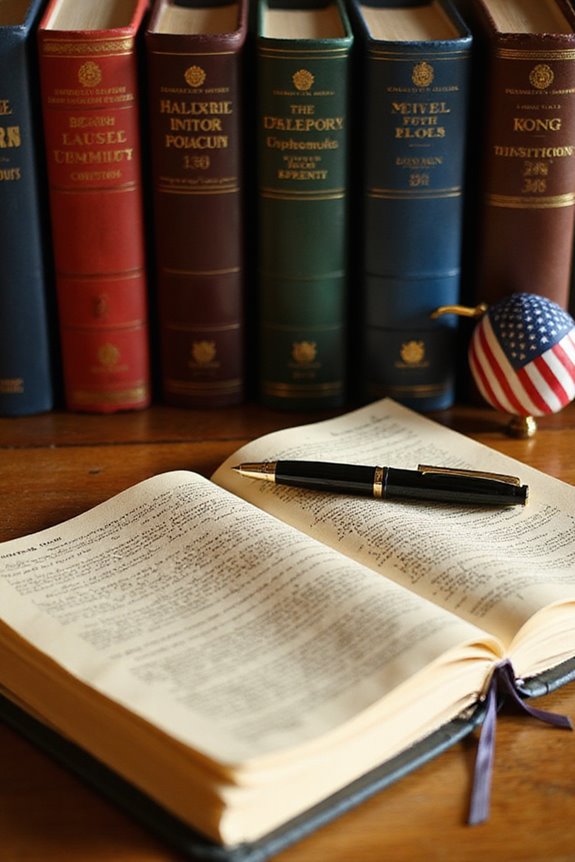When exploring books on political propaganda, we find a wealth of knowledge that enhances our understanding. Key texts include:
- *The Crowd* by Gustave Le Bon, which analyzes collective behavior.
- Edward Bernays’ *Propaganda*, examining public opinion’s influence.
- Walter Lippmann’s *Public Opinion*, evaluating media’s effects.
These works reveal psychological techniques and historical contexts, showing how propaganda shapes societal values. By learning about these essential resources, we deepen our knowledge of this influential subject.
Key Takeaways
- Gustave Le Bon’s *The Crowd* explores crowd behavior, essential for understanding the psychological basis of political propaganda.
- Edward Bernays’ *Propaganda* offers insights into shaping public opinion through media and psychological techniques.
- Walter Lippmann’s *Public Opinion* examines media’s influence on political perceptions and the effectiveness of propaganda.
- Hitler’s *Mein Kampf* serves as a historical example of using propaganda for manipulation and control.
- Gabriel Tarde’s *Laws of Imitation* discusses social influence dynamics, relevant to understanding political propaganda’s effectiveness.
Classic Works on Propaganda
When we explore classic works on propaganda, we uncover foundational texts that have shaped our understanding of mass communication and influence. These classic texts provide vital insights into propaganda theory and its applications.
- Gustave Le Bon’s *The Crowd*: Analyzes crowd behavior, influencing modern propaganda techniques.
- Edward Bernays’ *Propaganda*: Discusses the role of propaganda in shaping public opinion, drawing from Freudian ideas. This work highlights the importance of political theory in understanding how messages are crafted to influence the masses.
- Walter Lippmann’s *Public Opinion*: Examines how media affects public perception, essential for understanding propaganda’s impact. The development of propaganda techniques in the late 19th and early 20th centuries significantly enhanced the effectiveness of these classic works.
Other notable works include Gabriel Tarde’s *Laws of Imitation* and Hitler’s *Mein Kampf*, which reflect the dark use of propaganda. Each text continues to inform our understanding of how propaganda manipulates societal beliefs and behaviors across history.
Modern Perspectives on Propaganda

How have modern perspectives on propaganda evolved in the digital age? In today’s world, propaganda techniques have adapted to leverage technology effectively.
- Bandwagon Effect: Social media amplifies popular trends, encouraging mass participation. Additionally, the bandwagon effect creates a sense of urgency to conform to societal norms, prompting users to engage with trending topics. This phenomenon is similar to the way political campaigns utilize early primaries to gain momentum.
- Emotional Appeal: Digital platforms exploit emotions over logic, targeting user sentiments. The use of humor in political communication can significantly shape public perception and enhance voter engagement.
- Targeted Advertising: Algorithms facilitate the dissemination of tailored messages to specific demographics.
- Repetition and Framing: Continuous exposure shapes public perception and discredits traditional media.
Alongside these techniques, we must consider the ethical considerations surrounding propaganda. Impact assessments are essential in evaluating how these methods affect public opinion and democratic processes. Understanding this evolution helps us navigate the complex landscape of modern communication and its implications for society.
Media and Propaganda

Media plays an important role in shaping public perception and can serve as a powerful tool for propaganda. Understanding media influence is essential, as various techniques manipulate our views.
- Transfer Propaganda links ideas to positive or negative imagery, swaying opinion.
- Loaded Language uses emotionally charged words to create bias.
- Testimonial Propaganda features endorsements from authority figures to enhance credibility.
- Social Media amplifies these techniques, often spreading misinformation rapidly. Propaganda often involves biased or misleading content. Moreover, the use of humor in political discourse can also influence how audiences perceive serious issues, making them more approachable.
Propaganda ethics come into play when we consider the responsibility of media outlets in presenting factual content. Censorship can limit access to balanced views, making it necessary for us to critically evaluate information. By recognizing these strategies, we can better navigate the complex landscape of media and propaganda in our lives.
Propaganda in Historical Context

Understanding the historical context of propaganda enhances our awareness of its evolving strategies and impacts. Throughout history, leaders have employed ancient strategies to influence public opinion and achieve political goals. For instance:
- Themistocles used naval disinformation in 480 BCE, enabling a Greek victory against Xerxes.
- Alexander the Great projected power through imagery on monuments and coins.
- Julius Caesar’s sophisticated tactics enhanced his image within the Roman Empire. Additionally, the propaganda war between Octavian and Mark Antony post-Julius Caesar’s death exemplifies how misinformation can lead to significant political consequences. This evolution reflects the changing nature of political power dynamics, showcasing how leaders adapt their strategies to maintain control.
As time progressed, we saw modern adaptations of these techniques. During the American Revolution, figures like Benjamin Franklin crafted compelling narratives for independence. In the 20th century, totalitarian regimes utilized centralized propaganda, blending traditional methods with new media technologies to manipulate public perceptions effectively. This evolution illustrates how propaganda remains an essential tool in political discourse.
Cultural and Social Impact

Cultural and social impacts of propaganda are profound, as they can reshape societal values and norms over time.
- Cultural Shifts: Strategic propaganda campaigns, like Bernays’ “Torches of Freedom,” transformed smoking from a taboo into a symbol of emancipation for women. Furthermore, the CIA’s influence on book publishing in the 1960s exemplifies how the narratives promoted through literature can steer public opinion and change societal norms. This relationship between organized crime and politics also highlights the ways in which media can be manipulated to serve specific agendas.
- Social Change: These efforts leverage mass media to alter perceptions and encourage acceptance of new behaviors.
- Identity Transformation: Propaganda can redefine how communities view themselves, often embedding new values in popular culture.
- Taboo Breaking: By challenging long-standing norms, propaganda effects facilitate significant shifts in societal values.
- Enduring Changes: Once established, these cultural shifts can persist across generations, influencing future behaviors and beliefs.
Academic and Critical Studies
While we explore academic and critical studies in political propaganda, it becomes clear that this field encompasses a wide range of theoretical frameworks and methodologies.
- Propaganda studies define propaganda as a systematic use of symbols and narratives to influence public opinion.
- Interdisciplinary methodologies draw from history, communication studies, political science, and cultural studies to analyze its effects.
- Critical theory highlights propaganda’s role in reinforcing power structures and dominant ideologies.
- Research often includes empirical case studies on election campaigns across various regions, illustrating the growth of nationalism and populism.
- Techniques of psychological manipulation and misinformation are central to modern propaganda strategies, showcasing its evolution over time. Additionally, the impact of modern communication has been pivotal in amplifying political propaganda through digital platforms.
The Role of Media in Propaganda
The role of media in propaganda is vital, as it shapes public perception and influences political behavior.
- Government Influence: Governments often manipulate mass media content to disseminate propaganda efficiently. For example, during the Iraq War, U.S. federal agencies produced Video News Releases that blurred the lines between news and propaganda. This manipulation aligns with the concept of propaganda where misleading information is used to promote specific agendas.
- Social Media: Platforms have become significant for propaganda. By 2020, 81 countries conducted organized disinformation campaigns, exploiting algorithms to reinforce user biases.
- Media Ownership: Corporate ownership can lead to censorship, limiting critical perspectives. This information control guarantees dominant narratives face little public challenge.
Through these methods, media manipulation aligns public opinion with government agendas, demonstrating the profound impact media has on shaping political discourse.
Psychological Mechanisms of Propaganda
Understanding the psychological mechanisms of propaganda is essential for recognizing how it shapes public opinion. Propaganda employs various strategies to influence individuals through psychological conditioning and emotional resonance. Here are some key mechanisms:
- Classical Conditioning: It pairs specific stimuli with desired responses, creating automatic reactions.
- Emotional Association: Words and images evoke emotions, influencing attitudes and behaviors.
- Fear and Anxiety: Propagandists exploit these feelings to sway public opinion.
- Social Influence: Group dynamics and authority figures reinforce propagandistic messages. Social influence is a key element of propaganda.
- Cognitive Dissonance: This theory encourages individuals to align their beliefs with the propaganda to reduce internal conflict.
Case Studies of Propaganda Campaigns
Examining various case studies of propaganda campaigns reveals how these efforts have shaped public perception and political landscapes throughout history.
- World War I (CPI): The U.S. Committee on Public Information used posters and films to create anti-German hysteria, demonstrating propaganda effectiveness in swaying enlistment and bond sales.
- Soviet Bolsheviks: They utilized visual messaging and strategic propaganda to gain support during the 1917 Revolutions, influencing both domestic and international perceptions. This included emotional manipulation to foster a sense of unity and purpose among the populace.
- Kaiser’s Industrial Propaganda: In promoting Vanport City, they linked housing improvements to workforce morale, illustrating social engineering’s role in wartime production.
- British Propaganda: By controlling news and spreading atrocity stories, they shaped narratives in both World Wars, influencing public sentiment greatly.
These cases exemplify how propaganda molds perceptions through strategic visual and narrative techniques.
The Future of Propaganda in the Digital Age
As we navigate the digital age, it’s essential to recognize how propaganda is evolving in response to new technologies and audience behaviors.
- Digital Influence: With over 5.56 billion internet users worldwide, social media platforms like X dominate communication, capturing 32.2% of the U.S. internet user base.
- AI Integration: Marketers are increasingly adopting AI tools, with 71% planning significant investments. This reliance enhances content targeting and generates more personalized propaganda.
- Audience Expectations: Users demand authenticity, with 76% reporting that social media content influences purchasing decisions. Furthermore, 78.5% of the total internet user base in the USA used at least one social media platform, highlighting the pervasive reach of these channels.
Given these dynamics, the future of propaganda will likely focus on engaging narratives and strategic digital placements, ensuring messages resonate across diverse platforms and audiences. Embracing these changes will be vital for effective communication.
Frequently Asked Questions
How Can Individuals Protect Themselves From Propaganda?
To protect ourselves from propaganda, we should enhance our media literacy and apply critical thinking. By questioning sources, verifying information, and engaging with diverse viewpoints, we can better discern fact from fiction in today’s information landscape.
What Role Do Emotions Play in Propaganda Effectiveness?
Emotions are essential in propaganda’s effectiveness; they act as emotional triggers, often employing fear tactics to mobilize us. When we feel anger or fear, we’re more likely to engage and respond, shaping our beliefs and actions.
Are There Ethical Implications in the Use of Propaganda?
Imagine we’re traversing a digital landscape, where propaganda ethics often blur moral implications. We can’t ignore the potential harm; it distorts truth and erodes trust, necessitating a careful balance between persuasion and ethical responsibility.
How Does Propaganda Differ Across Cultures?
Propaganda differs across cultures due to unique cultural narratives and historical contexts. We see how national identity shapes messaging, with democratic societies often engaging in complex discussions, while authoritarian regimes simplify issues to fit their perspectives.
What Tools Are Available to Analyze Propaganda Critically?
When it comes to analyzing propaganda critically, we’ve got to separate the wheat from the chaff. Using rhetorical analysis and enhancing our media literacy are essential tools to navigate the complex messages we encounter daily.







